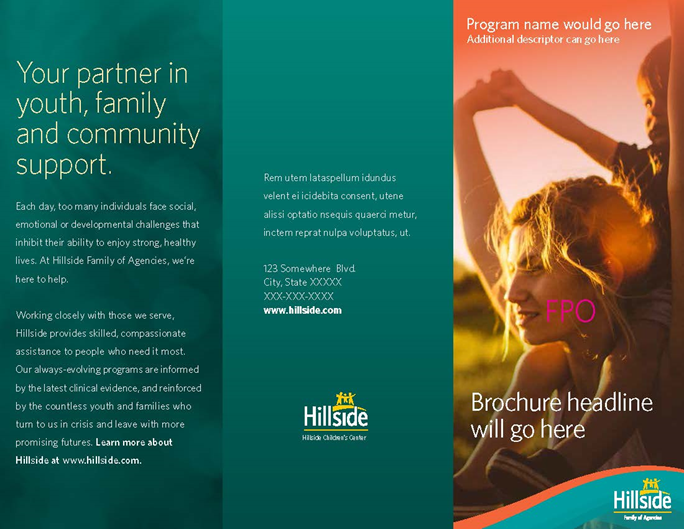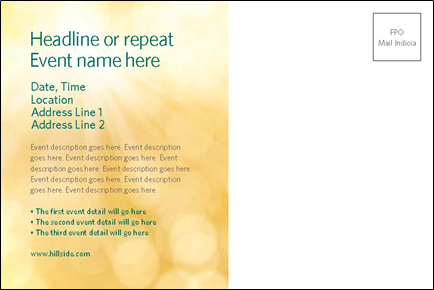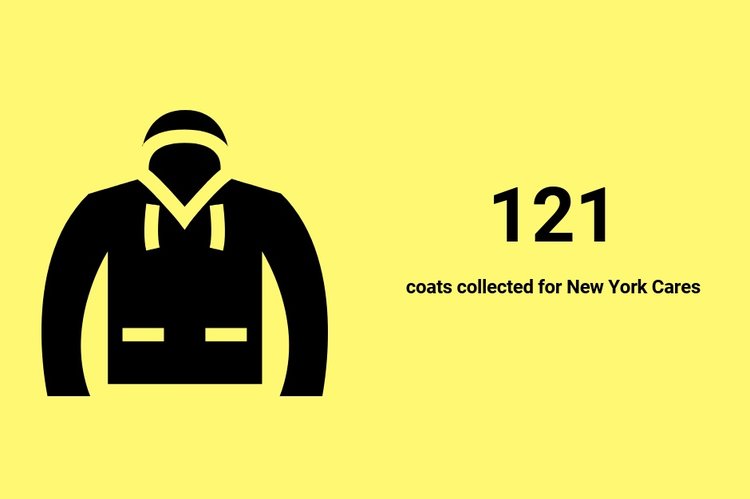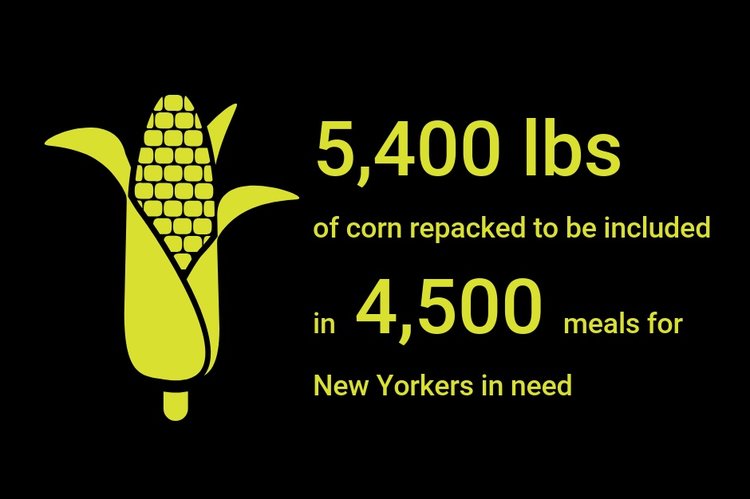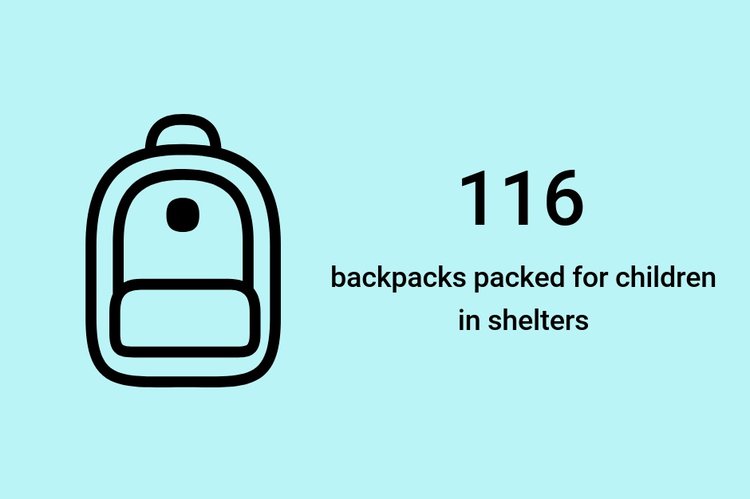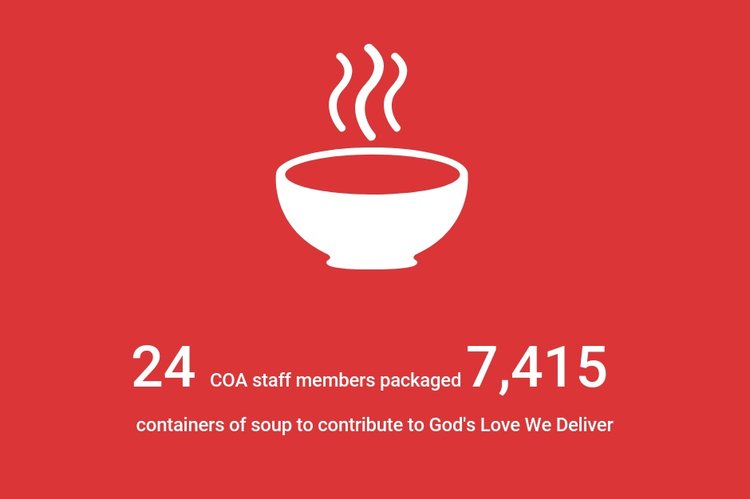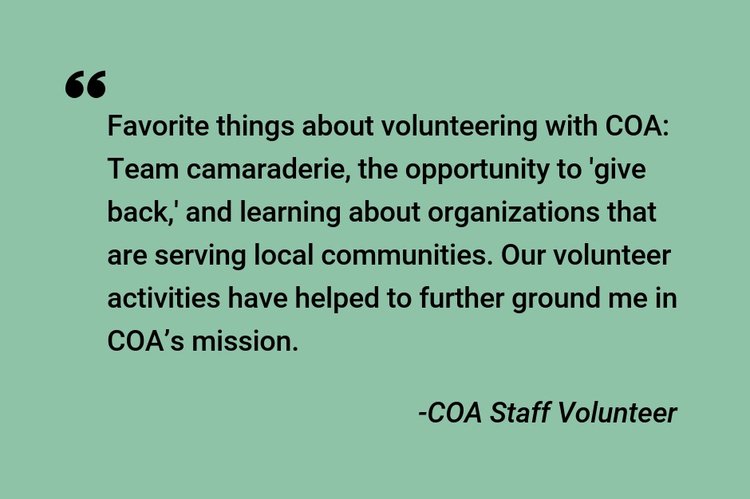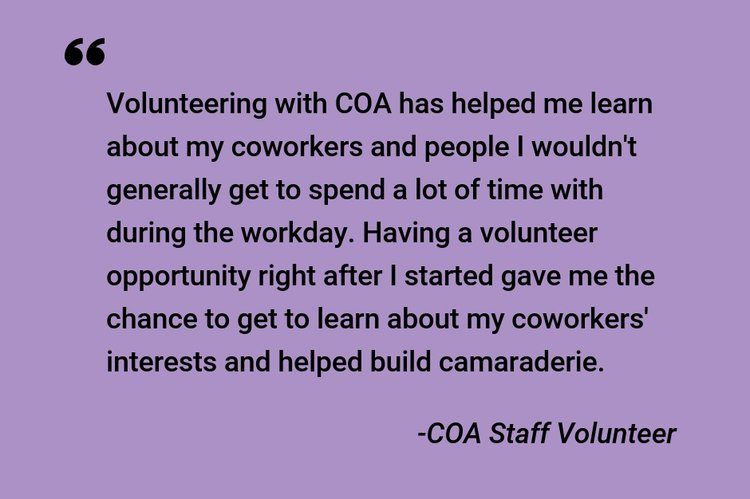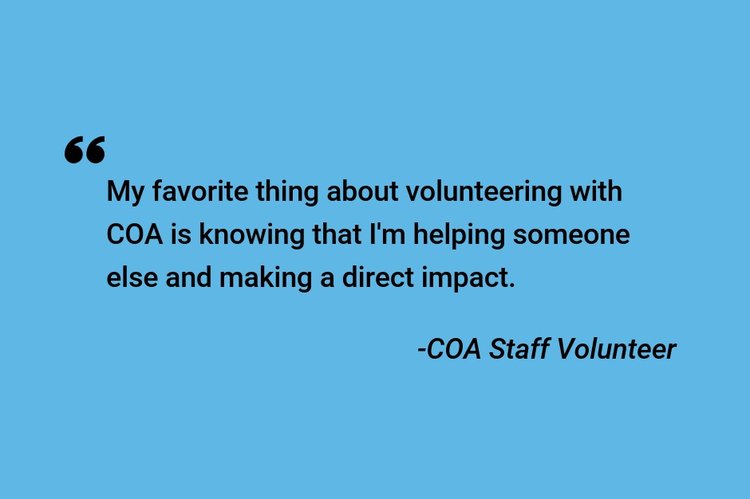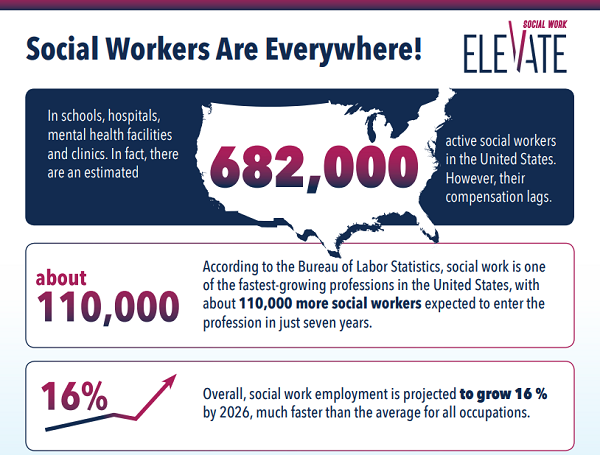Watch a special message from Jody Levison-Johnson, COA’s new President & CEO, and then read on below to hear more about her thoughts on what’s next for COA.
TRANSCRIPT
Hi. I’m Jody Levison-Johnson, the new president and CEO of the Council on Accreditation, or as some in the field like to call us, “COA (Kō-Ah).” I wanted to take a few moments to introduce myself and share a bit about the future of COA.
My background includes work in direct service organizations, oversight and funding entities, and national policy and advocacy arenas. Leading COA is the realization of my lifelong dream to shape the human services field and profoundly impact the lives of the people in need.
And the timing of my arrival here could not have been better.
This is truly an exciting time at COA. We are changing the field by helping organizations offer services of the highest possible quality to their clients and their communities.
For a long time and for many people, accreditation has just been another box to check, a means to an end to ensure eligibility for funding streams or to meet regulatory requirements. But it is so much more than that.
We hope to elevate–both within COA and among our accredited organizations–the true value of accreditation. That value is to the end user, the consumers—the children, youth, families and adults–who rely on the services that our organizations provide.
Our mission is simple: To help organizations improve the quality and effectiveness of their services by aligning with the best practices established in our standards.
Throughout our more than forty-year history, COA has regularly evolved both our standards and processes to meet the changing needs of the field. This evolution will continue as we move towards 2020. Look for more details on that in the coming months—we have some exciting updates just around the corner.
While we continue to evolve as an organization, one thing remains constant: COA’s unwavering dedication to supporting you so that you can best support your community and those that you serve.
Thanks to each and every one of you. We are so grateful for the work that you do every day on behalf of COA and the communities that you serve. Here’s to continued collaboration and success.
Notes from Jody
As I approach the six month mark at COA, I can confidently say that my excitement for our work has never been greater. I tease it a little in this video but want to encourage you again to keep an eye out for messages from us in the coming months—there is a lot to share, and I truly believe it will be valuable for you and your organizations.
Engagement with the broader human services community is the foundation of COA, from the critical input we get on our standards, to our peer-based review system, to the important partnerships with our sponsoring and supporting organizations, funders, and regulators. I have spent the last few months visiting with some of the COA community to learn how we can better support you and your important work. These meetings have provided me with an opportunity to hear about the profound impact COA is making on the field, and ultimately on those being served by our accredited organizations. Each meeting has also provided food for thought on areas for development–things COA can consider doing to continue to increase the value of our work.
That is our goal with the coming updates: to continue to make accreditation as valuable for our organizations and impactful for our communities as it can be. As always, we want to provide you with a framework that serves you so that you can best serve your communities. Because community is such an important part of COA, it is my hope that you will continue to work with us through this process, giving us feedback so that together, we can drive the field forward.
A big thank you to those who have met with me already and shared your thoughts–it has been invaluable. I hope to continue to keep in touch and look forward to meeting more of you in the future.
I am grateful to lead an organization with such a dynamic, diverse, and passionate staff, a robust team of talented and dedicated volunteers, and a versatile array of accredited organizations – all of whose commitment to quality is unwavering.
Here’s to what’s next.

Benchmark reports are increasingly common in the human services sector, but how do you know if this data is valuable to your organization? This blog post provides an overview of benchmarking and tips for evaluating the quality of benchmark data available to you.
What does a bench have to do with it?
Not much – unless you’re a craftsperson in antiquity. The term benchmark comes from the marks made on wooden workbenches to indicate shoe size (for cobblers), the length of board needed (for carpenters), etc. Today, a benchmark is a summary calculation – typically an average or median – which attempts to tell us what is normal for a metric.
Benchmarking within the human services sector usually comes in 3 flavors:
- Outcomes benchmarks are complex measures of change in behavior, thinking, or status. Examples include permanency in child welfare systems (such as these dashboards from the Minnesota Department of Human Services) or abstinence rate/reduction in use measures in substance use disorder treatment services. They speak to the success of a program, service, or intervention.
- Administration and management benchmarks are measures of organizational health and stability and target human resource management, financial management, governance, and similar activities. Related metrics speak to the foundational elements of an organization on which quality service delivery depends, and include staff retention rate, months cash on hand, or average board attendance rate.
- Fundraising/development benchmarks are measures of marketing and development success and efficiency. Examples include the open rate of an email seeking donations or giving rates by demographic categories. These benchmarks are the most commonly available (often at a price) as they are standard in marketing software solutions and easy to calculate and share.
What makes a good benchmark?
A benchmark is composed of 3 basic elements: the metric, the benchmark value, and the comparison group. You will need a strong definition of each to determine the value of a benchmark to your organization and should expect any quality benchmark report to outline them.
The metric
The metric should be clearly defined with a title, description, purpose, time period, and the underlying formula. Let’s use a common Human Resources measure, staff turnover, as an example:
Staff turnover is the rate of employees who leave an organization and are replaced by new employees in the stated fiscal year. This measure demonstrates an organization’s ability to maintain a stable and qualified workforce and is calculated as: (Total number of employees at the start of the fiscal year minus the total number of employees who left) divided by the total number of employees at the start of the fiscal year.
A well-defined metric is a strong indicator that all participating organizations calculated their figure consistently.
The benchmark value
This is the summary calculation and is typically an average, median, or—occasionally —a range of the sample. Here is a description of each:
- The average or mean is the “typical” value in the data. The average is only appropriate for data with a normal distribution (the bell curve shape) and is sensitive to outliers in the data.
- The median is the middle value in the data. It is less susceptible to outliers and appropriate for data with a non-normal distribution. Not sure what a normal or non-normal distribution is? No worries! The average and median will be extremely close if the data has a normal distribution, so—in any case—the median is always a safe bet.
- A full set of descriptive statistics provide a nuanced but complex view of the data’s distribution; it is the most illustrative method of describing benchmark data but can easily overwhelm most readers. These calculations can include: minimum value, maximum value, average, median, standard deviation, quartiles/percentiles, and the interquartile range.
The comparison group
The comparison group is comprised of the organizations participating in the benchmarking project. Understanding the comparison group is more than knowing the number of organizations which submitted data to the project; their overall demographic profile is the best way to assess the benchmark’s value to your organization.
What is the value of a staff turnover benchmark to a substance use treatment organization if the benchmark was generated using data from 100 arts nonprofits? A benchmark is only as valuable as its comparison integrity: the extent to which the comparison group matches the organization utilizing the benchmark to contextualize its performance. And this is what makes quality benchmarking so difficult.
A well-defined comparison group allows you to gauge the relevance of the benchmark to your organization. To have any value, a benchmarking project must collect a variety of demographic data about the participating organizations. Typical variables include:
- Revenue/budget amount: a general measure of organization size; other measures can include workforce size or average clients served per year
- Location: city, state, region, and/or community types such as urban, suburban, and rural
- Services provided: anywhere from general service categories (child welfare, behavioral health, etc.) to specific program models; this is exceptionally difficult because there are few taxonomies (systems of categorization) for human services
Why is a good benchmark so hard to find?
Generating high-quality benchmark data is a complex, time-consuming task, and, for many benchmarking projects, there is no guarantee of success. A benchmarking project requires the following.
The participants
As stressed above, coding the demographic characteristics of participating organizations is paramount. Other demographic variables typically include organization size (determined by revenue or employee count), location (region, state, and/or city), types of clients served (age, needs, or similar), and – principally – the types of services provided by the organization.
Unfortunately, the only ubiquitous, standardized method of coding human services organizations by services provided comes from the National Taxonomy of Exempt Entities (NTEE) code assigned to all tax-exempt organizations by the Internal Revenue Service (IRS); see a complete list here. However, because this code is determined solely by the IRS, it may not accurately reflect the organization’s actual services.
Well-defined, desirable metrics
The entity leading the benchmarking project must identify commonly-accepted metrics for which participating organizations see a valuable ROI. There must be clear definitions and calculation steps for each metric (yes, the dreaded data dictionary), and participating organizations must agree on their value.
Two-way reporting system
Participating organizations must have a way to provide their data and receive a benchmark report in return. Ideally, this benchmark report is dynamic and displays the data submitted by the organization side-by-side with the benchmark figure.
Quality assurance system
The system to collect and store data must have quality assurance checks to both prevent bad data from entering and identify bad data if it circumvents initial safeguards.
Longitudinal data
The best benchmarking projects will repeat their procedure on a regular schedule and collect data from the same group of participating organizations, or a fluid group of participating organizations with similar demographic characteristics.
Why utilize benchmark data?
There are 4 great reasons to seek out external benchmark data relevant to your organization.
1. Share your success with clients, grant-makers, regulators, and your Board of Trustees
These folks love data, and you love contextualizing your performance. Enriching your reports with external benchmark data can further highlight your successes, pad seemingly-poor performance (“Our turnover rate has risen but is still well under industry benchmarks”), and demonstrate your love of data and participation in the human services world beyond your walls.
2. Feed your performance and quality improvement system
A rich, enmeshed performance and quality improvement (PQI) system is the cornerstone of the Council on Accreditation’s standards and process. From the PQI standard itself:
COA’s Performance and Quality Improvement (PQI) standards provide the framework for implementation of a sustainable, organization-wide PQI system that increases the organization’s capacity to make data-informed decisions that support achievement of performance targets, program goals, positive client outcomes, and staff and client satisfaction. Building and sustaining a comprehensive, mission-driven PQI system is dependent upon the active engagement of staff from all departments of the organization, persons served, and other stakeholders throughout the improvement cycle.
Your organization is likely benchmarking performance already – that is, anytime you look to past performance to evaluate current performance. But finding benchmarks derived from peer organizations further contextualizes performance and pulls your organization out of the limited, sometimes-myopic world of its own data.
3. Get folks talking!
If you use dashboards, you’re probably seeing the same data every day. The line rises; the line falls. The number goes red; the number goes green. Over time, familiarity with the trends in your data can be desensitizing. You understand what is normal and what is not – but all of this happens within the insular universe of your organization.
External benchmark data – and particularly longitudinal benchmark data – gives more context to performance and can reinvigorate data-informed conversations which have faded over time.
4. Set goals and acknowledge high performance
Your performance and quality improvement system craves goals as a driver of performance. External benchmark data can be a powerful tool for pushing staff/programs, but this data can also further celebrate staff/programs performing above the benchmark.
What has been your experience with benchmark data?
Tell us your favorite sources of benchmark data or how you’ve integrated it into your organization’s operations in the comments below!
If you were to open a newspaper and select an article at random, chances are you would hit a piece on the American opioid crisis. Whether the news is about a pharmaceutical company being taken to court, a Democratic presidential nominee hopeful’s plan to address the climbing overdose rates, or a report on the effectiveness of Heroin Assisted Therapy, opioid news is everywhere. Does all this attention mean we can expect the crisis to abate?
Most likely not. Projections of opioid fatal overdose rates predict a sharp rise in the coming years, with an optimistic peak in 2022 before leveling off. Dr. Donald Burke, a researcher into the American Drug Epidemic, points to the increasing percentage of individuals who first use after exposure to prescriptions and continue to misuse despite the government’s tightening of regulations as evidence for the continual steady rise. He cautions that “the US has experienced four decades of exponentially increasing overdose deaths, so stabilization in the next 2 to 7 years may be more of a hope than a scientific reality.” One of the reasons for this may be that our current approach to targeting the opioid crisis is like targeting the stems of a weed—no matter how much we cut off, if we don’t address the roots, the weed will just keep coming back.
It may be myopic to treat the opioid epidemic as a unique factor in the decreasing American life expectancy. If you look up “Other (or Unknown) Substance Use Disorder” in the Diagnostic and Statistical Manual of Mental Disorders, 5th Edition (DSM-5) and compare it to opioid use disorders or any other substance use disorder, you will notice the same defining features. So what makes opioids unique? It could be that opioids’ special status comes more from the attention being put on it rather than the drug itself. In the past decade, researchers have found an increase with what they refer to as “deaths of despair”: an overall rise in deaths related to alcohol, illicit drugs in general, and suicide. To address the opioid crisis, we need to look at it in context of these “deaths of despair” and explore its underlying causes.

Substance abuse on the rise
Opioids are not the only drugs that have been on the rise in the last decade. From 2008 to 2013, amphetamine-related hospitalizations increased 245%, and some states have seen the overdose rates surpass those of opioids. Texas is not only seeing a rise in meth use, but also seeing a related increase in rates of life threatening infections, such as HIV and MRSA. In 2015, the state of Wisconsin estimated that meth cost them $424 million, including both the cost of health care and lost productivity. Even opioid overdoses are often not just from opioids: 30% also involve benzodiazepines.
Illicit drugs are not the only culprits when it comes to drastic rises in substance abuse. Between 2002 to 2013, problem drinking rose to the level of a public health crisis, especially among minorities and women, and to unprecedented levels in older adults. According to the CDC, in 2018 over 25% of high school students used a tobacco product in the past 30 days. Beyond the Juul fad that we commonly associate with youth, we have seen a rapid growth of e-cigarette use in adults, with 1/3 of current adult e-cigarette users being those that consider themselves “nonsmokers.”
When you start to look at the numbers it becomes clear: We don’t just have an opioid problem. We have an overall substance abuse problem. This doesn’t even factor in some of the other consumption related disorder (eating, gambling, screen addiction, etc.). Looking at these unhealthy relationships with external stimuli, you can’t help but wonder: What is happening in America to make matters so desperate?
Deaths of despair
“Deaths of Despair” may sound like a line from an Edgar Allen Poe poem or a new Taking Back Sunday album, but it’s what’s at fault for decline in the average age of American life expectancy. Deaths of despair are commonly agreed upon as those involving drugs, alcohol, or suicide—deaths related to pain, distress, and social dysfunction. Adults between the ages of 18 to 34 have been hit particularly hard–in 2017, 36,000 died from a “death of despair.” For adults between the ages of 45 to 54, the mortality rate rose by a half percent each year from 1993 to 2013. While not as dramatic, that increase has accounted for an alarming decreased life expectancy. If you look at this time period from a societal standpoint, there are a few things that pop out: the Great Recession, the rise of social media, and a rise in loneliness.

While the Great Recession can’t account in its entirety for the current public health crisis, it has played a role. For every 1% increase of unemployment rates, there is a 3.6% increase in opioid-related deaths and 7% increase in emergency room visits, as well as an increased use of tobacco, problem drinking, and other illicit drugs. A comparison of data today versus data from of adults in the mid-1990s and early 2010s shows there have been significant increases of mental and emotional distress, especially among individuals with a lower socioeconomic status.
With increasing rates in social media use, we have begun to see a positive correlation in increasing rates of loneliness. Loneliness has been shown to be positively correlated with suicidal ideation and parasuicide behavior, and a study on young U.S. adults (between ages 19 and 32) found that those with high social media use (around 2+ hours per day) were more than three times as likely to have perceived social isolation, one way that social scientists operationalize loneliness. Studies have shown that conversely, limiting social media use to 30 minutes per day leads to significant improvement in well-being, showing a causal link between the two. Dr. Oscar Ybarra, a professor of psychology at the University of Michigan, theorizes that social media activates social comparisons in users, leading to feelings of inadequacy. While social media can be used effectively as a community builder, it is hard to ignore the relationship between the increased use of social media and the increase of factors that can lead to suicidal thoughts and behaviors, another form of the deaths of despair.
In addition to these factors that cause distress, there has been an increasing sense of loss of community, a protective factor known to mitigate these negative stressors. In his new book, Tribe: On Homecoming and Belonging, Sebastian Junger argues that on our path to modernity, America has paid with the currency of belonging. Much of modernity has been about perfecting the lack of need for others. As people feel increasingly like they can’t measure up to others and have a lower sense of belonging, we’re creating the perfect storm for alienation and depression.
Thinking of substance abuse as a biopsychosocial disorder highlights the relationship between trends in American society and our decreasing life expectancy. This in turn highlights how hard it’s going to be to tackle the opioid epidemic– there’s not going to be one easy solution. The tech sector has responsibility to create community instead of disrupting it, regulators have a responsibility to pass legislation to help get people the necessary supports they need, and we have a responsibility to each other. The opioid epidemic isn’t going to go away any time soon, but we certainly can’t speed up its departure by continuing to ignore the root of the problem.
Too often great ideas are kept in-house without recognizing their potential to create change beyond the communities where they are born. COA’s Innovative Practices Award (IPA) identifies, documents, and celebrates examples of successful approaches to management and service delivery practices adopted by our accredited organizations.
In 2018, a committee made up of COA volunteers and staff selected 6 finalists from over 45 Innovative Practices Award submissions to move forward with a full case study. The St. Louis-based Foster & Adoptive Care Coalition’s 30 Days to Family® came out the winner. Read on to find out how 30 Days to Family® is leading the charge to create stability for kids in the chaotic world of foster care.
Seven siblings entered foster care when they were discovered in deplorable conditions with no food or water. With no known relatives in the area, they were split up between four separate, distant foster homes. Eight days after our team stepped in, all children were placed together, and, one year later, are still in the same home.
Maliek’s father’s beating sent him to the hospital. Lost to addiction, his mother was nowhere to be found. His grandmother, a refugee from the Rwandan genocide, wanted custody, but because she spoke limited English, the licensing team refused to accommodate her. His aunt also wanted custody but lived out of state. The Coalition stepped in to provide translation services and one-on-one training with grandma so she could become a licensed relative provider for Maliek while his aunt went through the lengthy ICPC process. One year later, Maliek was happily in the guardianship of his aunt, his grandmother living in to assist with childcare.
* * *
By the start of the opioid epidemic in 2011, the St. Louis-based Foster & Adoptive Care Coalition had become family-finding experts. We were the first agency in the country to utilize full-time private investigators, and our work was featured in The New York Times and TIME Magazine. But like everyone else, we were doing family finding for children who had already spent years in foster care.
Why were we waiting? We know that long-term foster care is bad for kids. We know that extended family experience deep grief because they’ve lost a child to the system for years. And we know that relatives often respond to requests for help by telling us, “I said I could help years ago, but then nothing happened.”
The Fostering Connections Act of 2008 mandated that all family members be alerted within 30 days of a child entering foster care, but we know that doesn’t happen. Lack of time, tools, and training mean a caseworker identifies an average of only seven relatives. Though a safe, appropriate family member could have been found, a nonrelative foster parent is called and, as a result, children suffer in isolation from their culture of origin, school, neighborhood, and church.
To make matters worse, Missouri does not have enough foster homes to deal with a steep increase in the number of children entering care due to the opioid epidemic. In the last 10 years, Missouri has seen a 42% increase in new entries, with more than 20,300 children spending time in foster care in 2018.
Realizing an opportunity to do better work up front, we created 30 Days to Family®.
30 Days to Family® is an intensive, short-term intervention that places children in the homes of safe and nurturing relatives within 30 days of entering foster care. It works because 30 Days to Family® Specialists are required to find an average of 150 relatives for each child or sibling group. In the last eight years, we’ve learned many lessons about how to find and engage family. Here are the top three:
Work fast
Every night in foster care for a child is a night in crisis. That’s why we initiate 30 Days to Family® the moment a child enters foster care. A member of our team attends the child’s first protective custody hearing to create a sense of urgency around the case. The more time a child spends in care, the more likely it is that relatives will fall away or disengage. Immediacy is key.
And that attitude of immediacy permeates every aspect of every case. If a relative expresses interest in providing placement, we drop everything and assess for safety on the spot. Relative foster parents shake up their entire lives when they agree to care for our kids; the least we can do is match their enthusiasm and flexibility.
“We operate from a mindset of ‘don’t put off tomorrow what can be completed today.’”
When it comes to 30 Days to Family® cases, regular business hours do not apply. We operate from a mindset of “don’t put off tomorrow what can be completed today.” The early tasks in a case are critical for setting the tempo and tone of everything that comes after. Our team never wants to let an opportunity slip through their fingers to find a safe, appropriate relative for a child and get the whole professional team on the same page.
But we don’t slow down once a relative steps forward. Our Specialists bring the same sense of urgency to support as to recruitment. We will not allow a disruption because daycare isn’t in place and the caregiver has to choose between a job and a child. This person became a parent days ago – they have a million things to deal with and calling daycares for openings or doctors for Medicaid eligibility distracts them from meeting the needs of the child in their care.
Engage everyone
When it comes to our kids, everyone has something to contribute. While they may not be able to take placement, a retired uncle may be able to transport the kids to appointments, grandma could watch them after school, or a cousin could help cook dinner on her nights off.
You simply never know when you will find a relative with something amazing to give. To that end, we will contact every living adult relative despite their background, criminal history, abuse and neglect history, social situation, or living conditions. Even if they aren’t appropriate for placement, they may know of a long-lost relative who will prove invaluable in supporting the family. Everyone has a piece of the puzzle.
Often, our team will hear that an aunt or grandparent doesn’t want to be involved – they had enough of mom and dad years ago. Or maybe they don’t trust the child welfare system. A key to our success has been to never take that at face value. We always reach out to hear their story, and often find that if we listen actively and with empathy, they will become an active part of the child’s life.
Another thing that sets 30 Days to Family® apart is its commitment to involving paternal relatives. We do not wait for paternity to be established to reach out, as we’ve found that cousins or grandparents will often step up if they know the children. Biological relation is not a deciding factor for many of our caregivers. Many will ask for placement even after a conclusive paternity test shows they have no relation to the child.
However, we do always attempt to establish paternity. We know kids do better when they’re connected to family. To that end, we’ll do our best to give them as much information as possible. We’ve even begun conducting our own paternity tests to speed things up.
Support always
“Focusing on natural supports strengthens the caregiver’s existing social network, offers more flexibility, and gives kids more relative connection.”
Just as important as finding a relative placement is putting an end to what we call “relative dumping”– you know, when grandma is asked to take in her four grandkids with no support. Say grandma has a good job at a factory, but inflexible shifts. Suddenly, all the kids in her care need physicals, dentist appointments, psychological exams, new school enrollment, court dates, and team meetings – all within a month. Instead, our team utilizes our proprietary Roadmap to Family, which guarantees all formal and informal supports are in place to keep grandma focused on caring for her grandkids.
The Roadmap to Family is a thorough, culturally competent plan created in concert with the family. Everyone has buy-in and makes a commitment. Our team focuses on “natural” supports rather than “prescribed” supports: We’ll find a cousin to take the kids to their doctor’s appointments rather than rely on public transportation, or an aunt who is a math teacher instead of hiring a tutor to help with homework. Focusing on natural supports strengthens the caregiver’s existing social network, offers more flexibility, and gives kids more relative connection.
Another key to 30 Days to Family® is the inclusion of backup placements, often more than one. Should a placement disrupt, having multiple relatives lined up to step in ensures that the kids stay with family and are not forced to go to a stranger’s home. It eases the burden on overworked caseworkers, who otherwise might place the child in residential care due to a shortage of available nonrelative foster homes. Our team fully vets each backup as though they were taking immediate placement, so there is as little friction as possible in the event a disruption happens.
Finally, we conduct intentional, direct follow-up with caregivers at two weeks and 30 days after the end of services. We want to know if and how they’re utilizing the Roadmap to Family, if there’s any support they lack, any barriers they’re facing, or if they feel there’s any risk of the child disrupting. We want to make sure they feel supported and set up for success. If the caregiver needs anything, our team jumps back in – whatever needs to happen to minimize the disruption in the child’s life.
What’s in it for our kids?
In 2015, we secured funding for a multi-year, independent study of the 30 Days to Family®. Dr. Anne Atkinson with PolicyWorks, Ltd., a think tank based in Virginia, matched children served by 30 Days to Family® with comparable children who received services that were business as usual. The results were stunning. Children served by 30 Days to Family® exited foster care 91.4 days earlier on average. If the child had an identified disability, s/he exited foster care 257.8 days earlier. Not surprisingly, most children achieved permanency through reunification, adoption by their relative, or guardianship, reducing the need for nonrelative adoptive homes. Also, children served were half as likely to spend time in an institution (26% vs. 14%). Excitingly, children served were 81% less likely to experience placement disruptions.
By increasing permanency and stability and reducing the toxic overuse of residential treatment, 30 Days to Family® has created resilient placements which created a wide range of benefits for children, such as:
- More positive relationships with mom (61% served vs. 30% not served)
- More connection to paternal relatives (79% vs. 29%)
- Greater involvement in extra-curricular activity (60% vs. 45%)
- Higher employment for working-age teens (60% vs. 21%)
Additionally, Dr. Atkinson’s study was the first economic child welfare study of its kind in the United States. It demonstrated that every child served by 30 Days to Family® saves taxpayers an average of $10,217.61. Average savings increased to $21,687.26 for children nine and older. These numbers do not include intangible benefits such as reducing foster parent recruitment costs and easing caseworker workload. Neither does it include second-and-third-tier benefits, such as reduced Medicare costs and savings from lower percentages of children spending time in institutions. Our 30 Days to Family® Specialists can serve a minimum of 30 children per year, resulting in at least $300,000 in savings.
* * *
Family search and engagement takes work, but the rewards are worth the up-front investment of your time and resources. 30 Days to Family® represents the way forward for an overburdened child welfare system. By deepening family involvement and relationships, we build resilience among our most vulnerable children and increase buy-in in our community. By creating stability in their chaotic lives, we give our kids a chance at a genuine childhood, in which they can develop meaningful, long-term relationships, succeed in school, and pursue their passions. By being good stewards of public resources, we model responsibility and accountability. By rigorously evaluating and means-testing our own work, we set a precedent that children in foster care deserve the best we have to offer.
If your organization is interested in the 30 Days to Family® model, please contact the Foster & Adoptive Care Coalition’s Director of Program Replication, Melanie Moredock, at melaniemoredock @ foster-adopt.org.
The views, information and opinions expressed herein are those of the author; they do not necessarily reflect those of the Council on Accreditation (COA). COA invites guest authors to contribute to the COA blog due to COA’s confidence in their knowledge on the subject matter and their expertise in their chosen field.
Melanie Moredock
Melanie began with the Foster & Adoptive Care Coalition in 2011. Melanie’s previous child welfare experience includes residential treatment, specialized case management, and foster/kinship parent training and licensing. Melanie obtained her Juris Doctorate from Saint Louis University School of Law and has been a member of the Missouri Bar since 2007. Melanie’s passion is engaging and empowering family members, as well as working closely with the professional team members to ensure the laws regarding relative/kin placement are followed. Melanie enjoys sharing her knowledge of the program with others through providing individualized training and consultation to interested agencies and supervision of the 30 Days to Family® replication sites.
There can be many obstacles when promoting your organization’s services and overall mission. Many organizations find their efforts stalled by either limited resources or challenges around brand messaging. This often leads to an absence of universal buy-in, which is crucial. Hillside Family of Agencies, COA accredited since 2006, successfully navigated these common stumbling blocks by launching an organization-wide, ready-to-use, user-friendly collateral ordering system called the Turnkey Marketing Toolkit.
Hillside Family of Agencies (Hillside) is one of the oldest and largest human service organizations in the U.S., offering child welfare, developmental disabilities, education, juvenile justice and mental health services across central and western New York; Washington, DC; and Prince George’s County, MD. Through the five agencies – Hillside Children’s Center, Hillside Children’s Foundation, Hillside Work-Scholarship Connection, Snell Farm Children’s Center and Stillwater Children’s Center – that comprise Hillside, it serves 13,000 youth and adults annually. Its structure as a family of agencies allows specialization as well as a systematic approach to support children, youth and families aimed at breaking the damaging cycles of poverty, trauma and neglect.
So, how does a multi-state organization that serves a diverse group of clients create marketing materials with consistent branding for 100+programs hosting 100+events per year? We interviewed Brandie Cain, Senior Communications Associate from Hillside to learn more about the evolution of the Turnkey Marketing Toolkit to better understand the struggles and successes.
The beginning/the motivation
The project started when Hillside invested resources in a marketing team, a new endeavor for the agency. Before the arrival of the marketing team, each program was responsible for developing outreach materials for families, funders, partners and other stakeholders about their work. This created a duplication of design efforts and put their marketing pieces at risk for typos, inconsistencies in strategic messaging, design quality, branding, style and printing quality. For example, some programs used professional design tools like Adobe, some used Microsoft Word. Some printed items in-house and some used professional printers.
Once the team was in place, they were set to take on the challenge of refining Hillside’s mission and honing in on its impact while considering the diverse skills, identities and clients across the family of agencies. And the hurdles didn’t end there. Although centralizing a marketing team for support and quality control was a crucial foundation step, the team didn’t have the capacity to meet the oversight demand. The quantity of time-sensitive marketing materials requiring approval was too many for staff to manage and unscalable. The team saw an opportunity to innovate and got to work on a better process.
Understanding the work
As a first step, the marketing team engaged with the programs by attending staff meetings to review the content created by programs and better understand their marketing needs. They approached program staff with the perspective of being a support, not an enforcer, which helped build a foundation of trust.
Through this outreach effort, the marketing team found similarities across programs and carefully planned what collateral was needed, finding a balance between customization for each program and consistency needed for organization-wide branding and messaging. This balance was essential to gain buy-in from program staff who were accustomed to creating materials to meet their needs and transition them to shared pieces that could serve many programs.
Determining types of collateral to produce
After this assessment/evaluation was conducted, all of the marketing pieces that were being created by programs fell into one of two categories:
- Event-based – fundraisers, trainings, outreach events, etc.
- Informational – overview pieces about a program’s work, information about becoming a foster parent
With this categorization, the marketing team was able to narrow down the types of collateral to brochures, posters and postcards. The team created slight variations for each and templates with organizational colors, branding and messaging. Additionally, the templates contained designated areas and prompts for important event and program information.
Centralizing design
By creating these templates, the marketing team saved countless hours of work by eliminating the need for program staff spend time making design choices – things like font hierarchy (styles for titles, headers, sub-headers and paragraph text), where text should be placed (on or next to photos) and text alignment.
The templates allowed these design choices to be made by the experts in design – the marketing team! As much as we wish to believe that there’s a budding graphic designer within all of us, we’ve also all experienced a formatting task that took twice as long as expected and produced a less than desired result. It’s been said before and it is true – good design takes a lot of work.
Lastly, one of the greatest benefits of the centralized templates is the marketing team can now easily roll out new colors, logos, and messaging without worrying about old versions being used.
Creating customization
The marketing team knew that programs still needed the ability to customize content to reflect the services provided by each program and convey event specific information. Therefore, they crafted the brochure template language in a way that wove together organization-wide and program-specific messaging. The templates provide paragraph length guidance and bullet list prompts to help programs frame their work in concise messages.
More importantly, programs are able to change the photos in the templates to select images that will resonate with its stakeholders. In consultation with the programs, the marketing team curated and now maintains a high quality image library. The marketing team ensures that all of the photos are available for use and credited appropriately, thus eliminating the risk of copyright infringement or use of photos taken of clients or stakeholders without permission. The photos are pre-formatted to fit the templates and program staff can easily drag and drop which photos they would like to use in each piece.
Operationalizing
Next, the marketing team worked to set up an infrastructure and made sure it addressed anticipated pain points. They knew in order for people to use the new Turnkey Marketing Toolkit, it needed to be fast in turn-around time (72-hour target), easy to use, save order history, offer simple re-ordering, and produce high quality pieces.
They worked with a printing vendor to create an online system with the ability to create user login accounts with order history and an approval hierarchy that allows the marketing team to approve content (quality control) and program supervisors approve large orders (expense control). A link to the portal was shared internally with leadership and program staff and then placed on Hillside’s website for all to access.
Launching the Turnkey Marketing Toolkit
Building on the relationships created during the assessment and building phases, the team rolled out the Turnkey Marketing Toolkit during all-staff meetings hosted by programs. They shared how the new centralized tool facilitates collaboration of internal experts without duplication of efforts. The marketing staff contribute the branding and design and program staff contribute their knowledge of the appropriate imagery and audience-specific messaging.
Gauging success
The Turnkey Marketing Toolkit was well received and program staff quickly adopted the system for ordering materials. Now almost 3 years since its launch, they have experienced the benefits of consistency in the look and feel of collateral across programs, the reduction of marketing staff’s time reviewing and approving different designs, and access to organization-wide data on how many pieces exist and are printed annually. There also have been some unexpected benefits. For example, the marketing team is now aware of when events are taking place and can schedule a person to attend to take photos and gather stories to raise awareness about how programs are impact their community and persons served. In addition, the ease of use and quick turnaround time has fostered a positive collaboration and trust between marketing and program staff. That’s not to say it was flawless from the start. The system has had some trial and error/has room for improvement. The marketing team have made some tweaks to the system along the way, such as adding designated quantities for orders (50, 75, 100, 200, 500 max), adding watermarks to proofs to deter self-printing, and adding a cost allocation element so that each program is responsible for the costs of its order.
Shareable lessons
Hillside’s ability to innovate when presented with the opportunity is inspiring. They designed a solution that retained the programs’ ability to customize their content while relieving them of the heavy lift of the design work. The organization gained a birdseye view of the frequency of use and purpose of all collateral, quality control of text and design and maximized resources by centralizing design time, photography acquisition and printing costs.
If you find yourself with many mini-design and printing departments within your agency, setting up a structure similar to Hillside’s centralized Turnkey Marketing Toolkit could be a solution for your organization. Don’t have a Marketing Department? Crowdsource your templates through a staff competition and/or find a staff person with design skills and interest. Use online tools like Canva or Moo for free templates and on-demand printing. Create your own curated photo library with free photos from Unsplash, rawpixel, and pixabay. Have other great tools? Share them in the comments!
[vc_row][vc_column][vc_column_text]
Has all the buzz around National Foster Care Month (or the new HBO documentary!) inspired you to think about becoming a foster parent yourself? With 30-50% of foster parents stepping down each year and more and more children being placed into the child welfare system, the need for loving, stable foster families has never been higher. But is becoming a foster parent right for you?
Foster parenting is not easy–it can be one of the most challenging experiences in one’s life. It can also be one of the most rewarding. Providing a child with a safe, welcoming home can have a dramatic impact on both them and their family, which makes becoming a foster parent a way to truly make a difference. Children in need of out-of-home care have diverse characteristics and needs, so there are different types of foster care. Read on to find resources that can help you decide if one of these is a good fit.
Where to research if foster parenting is right for you
The National Foster Parent Association (NFPA) Website
A great place to begin your search into foster parenting is the NFPA website, which contains everything from introductory information on the application process to foster parents’ and children’s Bill of Rights and the history of foster care.
The site also has links to blogs that provide valuable insight from current foster parents about their experiences, as well as workbooks, support services, and more. There is even information for those who decide that foster parenting isn’t for them but that want to help out in the community in some other way!
The National Child Traumatic Stress Network’s Resource Parent Training Modules
Unfortunately, many children who enter foster care have experienced some kind of trauma. Combine this with the already fraught emotional situation of being separated from their biological family, and you can understand why some foster kids display challenging behaviors that can catch unprepared parents off guard.
The NCTSN offers training modules to help you learn about the types of trauma that children experience, how that manifests in behaviors, and how you can help a child feel safe. This might give you a taste of what to expect as a foster parent and help you decide whether it’s the right path.
Becoming a Foster Parent Guide from Adoption.com
There are multiple steps to becoming a foster parent; it is a good idea to know what the process will entail before you get started. This post does a good job of mapping out the road to your first placement, and links to resources that can help you along the way.
Where to learn about specialized types of foster parenting
For Kinship Care: “Kinship Caregivers and the Child Welfare System” Fact Sheet
Hoping to foster a child from your own family? You probably have a few questions about how that might make you different from other foster parents and how to best navigate the child welfare system in order for your relative to get the best care possible. The Child Welfare Information Gateway has a helpful tip sheet that covers all of these issues, as well as other important topics like how to find services such as therapy, respite care, and financial support.
For Therapeutic Care: “What is Treatment Foster Care?” from the Family Focused Treatment Association
Children with significant emotional, behavioral, medical, or developmental needs require structured, specialized care. If the need for traditional foster parents is great, the need for specialized homes is even higher. This post covers the basics of treatment foster care and its benefits.
For LGBTQ Care: The Human Rights Campaign
The number of LGBTQ children and youth in the foster care system is disproportionately high. Many have experienced rejection from their families and are in special need of a welcoming home. The Human Rights Campaign offers tips on becoming a foster parent, how to find an LGBTQ-inclusive agency, the latest in LBGTQ adoption and foster care laws, and more.
Where to get started
Ready to take the next step? Search for a COA-accredited foster care agency near you here, and get in touch to begin the discussion of how to partner with them to become a foster parent.
You can also find the Child Welfare Information Gateway’s National Foster Care & Adoption Search directory here.
What are some other resources you’ve found helpful in your foster care journey? Share them in the comments!
[/vc_column_text][/vc_column][/vc_row]
[vc_row][vc_column][vc_column_text]
“How Do You PQI?”
This is phrase that COA came up with a few years ago to introduce our newest toolkit. As an accreditation insider, we think it’s a clever phrase in that it conveys that:
- PQI is a necessity
- PQI is something that you do and that has motion, and
- PQI is customizable.
(We also like that it rolls off the tongue easily, unlike the word “accreditation.”)
Unfortunately, not everyone is an accreditation insider. We love our acronyms at COA, and use them everywhere–in our standards, in our process, in our technology (shout out to the VIP portal!). But acronyms and jargon can be confusing to anyone not in the know, and create barriers to understanding. “PQI” is no different.
So what is PQI, you ask?
Good question–and a common question we’re asked when staffing COA’s exhibit booth at a conference. The conversation usually goes something like this:
Inquiring person: What is PQI?
Us: It’s the foundation of the accreditation process.
Inquiring Person: Yes, but what does it mean?
Us: “Performance and Quality Improvement.” It’s our name for Quality Improvement or Quality Assurance.
Inquiring person: Thanks. What’s “Quality Improvement”?
Us: On a basic level, we like to say that a PQI system is collecting data about your work, analyzing it, making course-corrections based on the data, and then tracking to see if those changes are working.
Then we usually see a glimmer of understanding in their eyes. We give the inquiring person our PQI Toolkit postcard, and hope that it makes its way to the Quality Assurance/Data Nerd at their agency.
Based on our conversations with stakeholders, in-process organizations, and peers, we at COA know that PQI is can be a conceptual, difficult-to-grasp concept. We also know that agencies need a lot of help developing their PQI systems. This is why we talk about PQI a lot, and why we create trainings and tools to help.
One long-awaited tool is a high-level introduction to PQI for anyone new to the concept. Now when we’re manning the exhibit table and get asked “What is PQI?”, we are thrilled to be able to reply:
“Check out our PQI whiteboard video!”
Transcript
The most effective social service organizations are those that have been accredited to meet the highest standards of quality.
For more than 40 years, the nonprofit Council on Accreditation has partnered with health and human service organizations globally to improve outcomes by developing, applying, and promoting accreditation standards.
COA’s Performance and Quality Improvement standards, or PQI, require organizations to generate and review organization-wide data to establish performance targets that improve services and outcomes for all stakeholders. It’s a comprehensive process that includes working with the entire organization instead of assigning the responsibility for quality improvement to just a few individuals.
Information generated by the PQI system is used to:
- Monitor progress toward achievement of strategic goals and long-term direction,
- Manage programs and operations efficiently and effectively,
- Meet funder requirements to promote the organization and its services throughout the community, and
- Support direct service staff to meet program goals and have a positive impact on people served.
The organization reviews findings and feedback while taking action to:
- Eliminate or reduce identified challenges,
- Replicate good practices,
- Recognize and motivate staff, and
- Improve services for the communities they serve and assist with fulfilling their mission.
And hopefully now you think the phrase “How Do You PQI?” is clever, too.
Want to dig deeper into PQI? Check out our comprehensive PQI Toolkit.
[/vc_column_text][/vc_column][/vc_row]
A big thank you to Danielle Cook for this guest blog post!
A vital element of any thriving relationship is communication. This truth extends to the dynamic between an organization and its stakeholders, and a blog is an effective channel for dialogue with those circling its orbit.
Organizational buy-in is key for any new endeavor. Your colleagues might ask, “What is the value of having a blog? We already have a website, isn’t that enough?” After taking a deep, cleansing breath, you can start enlightening them on the impact of breadcrumbs. Yes, you read that correctly. Breadcrumbs.
Thought provoking content designed to address the specific needs and curiosities of your community is the trail of breadcrumbs driving traffic to all of your assets, including your website. A blog allows an organization to demonstrate that it is a thought leader and offers an opportunity to be transparent about the organization’s opinions and processes, which helps to build credibility. Blog content can also be repurposed for your social media channels, newsletter, advertising, training and onboarding. It’s a cost-efficient way to share your mission beyond your current stakeholders, creating potential for new partnerships. Let’s take a closer look at the benefits:
Be a thought leader
A blog is a great place to showcase your organization’s excellence by spotlighting your expertise and accomplishments. You can prove your effectiveness by examining the issues impacting your stakeholders, sharing insight into how you arrived at decisions, and what led to your current processes. Have fun revealing your unique voice and abilities. You’re in control of your own narrative. Be empowered by the 1 percent rule: Only 1 percent of Internet users create new content, while the other 99 percent simply view it. If you want to effect change, then it’s crucial to stand out and be heard.
Stay informed and relevant
In order to create engaging content, your blog’s contributors must stay attuned to trending topics such as new legislation or evolving approaches to best practice. This might require collaboration with subject matter experts outside of your organization. The editorial process can help your organization stay informed and allow it to confidently participate in conversations that influence the field.
Nothing is more important than understanding your audience. Your staff will need to explore ways to gain information about your audience’s needs. Perhaps colleagues can shed light on the most frequently asked questions or common challenges among the population you serve. Ask to join departmental meetings, advisory committees and panels to gain insight into the issues being discussed. Look at existing surveys distributed by your organization. Learn from analyzing both the data and how your organization is asking the questions. Perhaps you can find an unexplored angle by approaching a familiar topic differently on your blog.
New partnerships and opportunities
A blog welcomes conversation. Your readers will be able to share feedback, experiences and knowledge in the comments section, which might inspire a new post or be “the beginning of a beautiful friendship”. A blog is better than a business card. It allows you to establish familiarity with new clients, volunteers, donors and funders, which can convert to valuable professional relationships. This can lead to new business or an invitation to contribute to an influential blog, participate on a panel or advisory committee or present at a conference. It might also attract influencers interested in contributing to your blog. Being associated with influencers can help build brand awareness. It can also be a way to reintroduce your organization to your community, leading to new partnerships with organizations with a shared mission or service population, thereby, strengthening the overall impact of your work.
Professional development
Contributing to an organization’s blog not only allows staff to hone their written communication skills, but also allows them to practice communicating and understanding their mission. This challenges them to think about their mission beyond their day-to-day work. It forces staff to understand their skills, organize their thoughts and learn how to articulate their ideas and knowledge. Writing a blog post is a measurable performance goal and allows staff to expand their comprehension on a subject. It also encourages staff to form and express opinions, which can galvanize them to question the status quo and motivate them to recommend improvements within your organization.
A blog can be a helpful resource for new staff to learn about an organization, the services they provide, their unique culture and vernacular and the community with which they associate.
Getting started
Once you get the green light from leadership, start mobilizing the troops! Form a blog committee and recruit staff to join. Work with leadership to create a communication plan. Be clear about expectations around participation.
Meet with your technology team to discuss where the blog should live. Ideally, your blog will be a part of your existing website, driving traffic to your website and giving your organization complete oversight.
Don’t fret if this isn’t possible. There are plenty of easy-to-use blogging platforms available for a nominal cost. Determine what you need before shopping around. Most platforms don’t require much maintenance, are friendly to beginners and have 24/7 customer service. There will most likely be limitations around customization, but this is often not an issue for those less tech savvy. You’ll find that most platforms will integrate with a customer relationship management system or software like Google Analytics. That said, most blogging platforms have built in analytics. Tracking analytics will assist you with communicating with your audience. As you gain a better understanding of your audience’s behavior you will be able to tailor content to their interests and improve upon the blog’s user experience.
Educate your committee about best practice for creating a blog. There are many elements to consider beyond aesthetics, although a style guide is useful. This will include developing policies and procedures. Check in with your technology team, because they probably already have policies and procedures in place related to media and technology for existing assets.
Every organization will approach this process differently based on their expertise and resources. No matter where you start, push yourself and your organization to dive a little deeper to find new ways to examine your organization’s important work. Learn about what challenges and motivates those in your community and the impact of their hard work.
The views, information and opinions expressed herein are those of the author; they do not necessarily reflect those of the Council on Accreditation (COA). COA invites guest authors to contribute to the COA blog due to COA’s confidence in their knowledge on the subject matter and their expertise in their chosen field.

Danielle Cook
Danielle Cook is a freelance content creator and editor. She is passionate about developing valuable resources for those in the human services field. If you can’t find Danielle playing Attack from Mars at her local pinball laundromat (yes, she lives in Brooklyn) then she’s most likely writing songs with her husband for a friend’s birthday (it’s the gift that keeps on giving).
At COA, volunteerism is the thread that binds us together and allows us to carry out our mission. Whether volunteers are helping our accredited organizations or running our site visits, COA would not function without them.
This is why we like to pause every April to celebrate National Volunteer Month. Established in 1974 by Presidential Proclamation, National Volunteer Month aims to both celebrate volunteers and unite the nation in increased volunteerism throughout the month. According to the Bureau of Labor Statistics, over 62 million Americans volunteer at least one hour each year, with the average amount of time equaling to approximately 50 hours per person (that comes out to about 3.1 billion hours of donated time!). Previously we have acknowledged Volunteer Month by writing about starting a workplace volunteer initiative and had a guest post from one of our many wonderful volunteers. This year, we decided we wanted to get a bit more personal. How does COA staff connect with our own volunteer initiatives? What impact does it have on the communities we serve as well as our own? What can others learn from our story?
In 2012, COA staffers spent a day on Staten Island, cleaning out a home affected by Hurricane Sandy. The devastation was sobering. It helped us to realize that we were eager to give back outside of our day-to-day work. This led to the formation of an interdepartmental group to spearhead employee volunteer opportunities, now known as the COA Volunteer Committee. Since its creation, the committee has coordinated drives, off-site activities, and in-house events.
How we’ve volunteered
Activities
The committee kicked off its efforts in 2013 by participating in “Repack in Hunts Point” with Food Bank for New York City during National Hunger and Homelessness Awareness Week. We traveled to the Food Bank’s Food Distribution Warehouse in the Bronx and were tasked with sorting, weighing, and packing corn to be distributed to food pantries and community kitchens throughout the five boroughs.
Another one of our favorite activities was volunteering with the Pajama Program in 2015. The program provides new pajamas and books to children in need nationwide, many of whom live in group homes, shelters and temporary housing facilities. Volunteers had the opportunity to read to children from Pre-K and second grade classes, share snacks, and hand out pajamas and a book for each child.
We loved working with kids so much that later that year we volunteered with Association to Benefit Children (ABC). We took a field trip to Battery Urban Farm and volunteers worked with two classrooms of three- and four-year-olds. We ate pizza. We rode the subway. We gardened… After we were done, we all needed a nap!
In 2017, we volunteered with Coalition for the Homeless, helping wrap presents for children living in their network of shelters. The gifts were distributed to 140 kids at their annual Kids Holiday Party and to other children experiencing homelessness throughout the city. This one definitely put us in the holiday spirit!
We did a second event in Spring 2017 working with God’s Love We Deliver, helping to prepare meals for individuals and families living with serious illnesses. We learned about their mission, put our hair nets on, and packed soup to be distributed across their network. This partnership has continued with a few additional volunteer opportunities in 2018, as well as planned events for this year.
Another organization we’ve worked repeatedly with is The Friends of Governors Island. We’ve enjoyed helping them weed, rake, and maintain landscapes for this beautiful island we are lucky enough to work near. This work allowed us to give back in a way that is outside the scope of our day to day responsibilities and is vital to sustaining the public green space.
Drives
In addition to off-site opportunities, the COA Volunteer Committee has also organized in different types of drives to support the work of various human service organizations. These have included:
- Collecting coats from staff and others in our building to support one of the largest coat drives in the New York City area, hosted by New York Cares
- Collecting essential winter items (such as scarves, gloves, and hats) for youth in the Safe Haven for Children program as part of Lutheran Social Services of New York, Inc.
- Collecting toys for children at the Dr. Katharine Dodge Brownell School (operated by Rising Ground, Inc.)
- Participating in a canned food drive for City Harvest
- Participating in a gift card drive hosted by Sanctuary for Families, a community-based organization for survivors of intimate partner violence, sex trafficking, and related forms of gender violence
- Participating in Project Back to School with the Coalition for the Homeless, collecting grade-specific backpacks and school supplies for youth.
In addition, we have an evergreen drive: With so many COA staff traveling across the nation representing COA at various conferences and events, we’ve made an ongoing effort to collect hotel-size toiletries to drop off at a shelter for survivors of intimate partner violence.
Our impact
Since 2013, COA staff have volunteered over 400 hours through the COA Volunteer Committee alone! We’ve seen the impact both internally and in our community.
Volunteering as an organization can give staff a forum to team build and bond, engage with the community, and increase morale.
When we polled staff about what they like best about COA volunteer opportunities, promoting team-building and building camaraderie came out on top. Staff also appreciate that the activities connect back to our mission and provide a space for us to get to know one another outside of the office. Another thing that we enjoy about our volunteer efforts? They give us the warm fuzzies!
At COA, volunteering has offered everyone a chance to give back, reconnect with our mission, and to “step away from our screens for a day to do good and spend time together while doing so.”
What we’ve learned
What are the barriers to getting a volunteer effort off the ground? Our staff report conflicting appointments and time away from the office as the biggest hurdles. Finding the time to volunteer can be a challenge when you have a full plate. The activities themselves, the environment, or the level of physical activity required can be other factors that change the response from “Count me in!” to “Maybe next time…”.
In the effort to keep our mission as a committee going and overcome these barriers, we’ve picked up a few tips and tricks to make our events more successful and have the greatest impact.
Schedule smart
Consider the nature of the event, time of year and weather in you planning – i.e. don’t plan an outdoor event if it’s commonly snowy that time of year. Keep in mind whether staff are typically on vacation or stacked with meetings on certain days. By making these considerations early, you’ll be able to maximize the number of staff that are able to volunteer for your event.
Find the right fit
When choosing a volunteer event for your organization it’s important to assess if there is an activity or event that is a particularly good fit for your organization. For example, our toiletry drive fit well with our frequent staff travels. You may also want to consider current events and needs in your area, like we did in our response to Hurricane Sandy.
Engage leadership
A key component of planning a successful volunteer event is getting buy-in from leadership to get the necessary permissions and gain their support and involvement. Engaging leadership at COA has enabled to us receive donations on behalf of the organization. Depending on the event and how your organization wants to contribute (time, items, $$$, etc.), there are a few approaches you can use to utilize that donation to its fullest. For our last backpack and school supplies drive, we recognized that backpacks were the most expensive item we were asking staff to donate, so we used COA’s donation to purchase backpacks.
Promote convenience
If you’re planning a volunteer event that will require staff to make donations, it’s important to make it as convenient as possible for them. If the expectation is that staff will bring things in from home, highlight the convenience of being able to clean out and drop off at their workplace. If staff will most likely need to purchase items for donation, we highly recommended setting up a registry. It provides specific guidance and easy purchasing options for staff and allows the organizer the ability to manage the items donated.
Offer incentives
Though the joy of donating and contributing to a cause is often enough to get people involved, incentives can be a great way to engage folks and reward their participation. When soliciting staff to participate in an off-site volunteer event we highlight the opportunity for out-of-office time, an option to dress down, and even snacks or lunch. We’ve also conducted raffles alongside events, entering all participants in a chance to win a gift card. Be creative and know what will incentivize your audience.
Send out reminders
People forget. Particularly if it’s 7AM and you’re trying to get to work. Make sure to send frequent reminders!
BONUS Tip: Even with reminders, we highly recommend allowing for some buffer time for sign up and donation deadlines (i.e. tell people the deadline is a few days before you absolutely need the commitment or donation).
Encourage volunteerism
If your organization doesn’t have the capacity to plan a specific event, create an avenue for staff to learn about volunteer opportunities. We place information on a white board in our communal kitchen and have a Slack channel solely dedicated to volunteer information. This way staff can get the information and choose to participate on their own time if they wish.
Whether you’re planning an event for your organization or doing something on your own, we hope you will get out there and volunteer this National Volunteer Month!
A big thank you to Greg Wright from the National Association of Social Workers (NASW) for this guest post!
Social work is a life-affirming and rewarding career field. It’s also one of the fastest growing in the nation, with over 100,000 people expected to enter the field in the next seven years. In spite of this, many social workers’ salaries tend to lag behind that of other helping professions like nurses, police, and high school teachers.
This year, during Social Work Month, the National Association of Social Workers (NASW) wants the public to pay more attention to this issue and spark a conversation on ways to end such pay disparity.
This year’s theme is “Elevate Social Work.” The theme has two meanings: We not only want to educate the public about how social workers uplift and empower members of our society, but also to let the public know that they must do more to support the field.
We are using a variety of tools to do this.
One is an infographic that sets out the facts. The demand for social workers is growing as our nation grapples with issues such as hunger, income equality, affordable housing, immigration, and the need for more mental health services. At the same time, the salary levels for social workers could improve. The infographic offers data on the average salary level of social workers by college degree and what sectors tend to pay social workers more. NASW hopes social workers and their allies can use the infographic to illustrate the case for higher social work pay.
In addition, we are offering a podcast series that features conversations with social work experts about the salary issue and what social workers can do to address it. Guests include financial advice guru Suze Orman, who earned a bachelor’s degree in social work; past NASW New York City Chapter President Robert Schachter, who helped lead a campaign in the city to boost salary levels; and Morgan State University Professor Michael Sinclair, who was New Jersey state coordinator for the Social Work p.r.n. national staffing service. We urge folks to listen to the podcast series and leave their comments on NASW’s Social Work Blog. NASW will be using these comments to weigh the next steps in addressing the salary issue.
Lastly, we have released a video public service announcement that looks at what our nation would be like if there were no social workers around. We hope social workers and their friends will share the video on their social media channels and ask their local TV stations to air it. The video will also be aired as an advertisement on YouTube throughout Social Work Month.

It is important to note that while NASW cannot act as a labor union and collectively bargain for social work salaries, we are working to improve those salaries in other ways. For instance, NASW supports the Improving Access to Mental Health Act, which offers clinical social workers more adequate Medicare reimbursement rates, as well as other legislation that would prompt our nation to invest more in its social work personnel.
Several NASW chapters have also supported initiatives for states to hire more school social workers, give social workers raises, or require government agencies to hire only qualified, licensed social workers for certain positions.
Of course more needs to be done to elevate the social work profession, and we know it will take all of us to do that. So during Social Work Month, take time to learn more about our campaign. Let us know what you think should be done to promote social work!
The views, information and opinions expressed herein are those of the author; they do not necessarily reflect those of the Council on Accreditation (COA). COA invites guest authors to contribute to the COA blog due to COA’s confidence in their knowledge on the subject matter and their expertise in their chosen field.

Greg Wright
Greg Wright is the public relations manager for the National Association of Social Workers (NASW), the largest membership organization of professional social workers in the world. Greg previously worked in public relations for the National Association of Manufacturers. A graduate of the University of Maryland, College Park, Greg had a long career in journalism, working for Gannett News Service/USA Today, Knight-Ridder Financial News, and Dow Jones News Service. Greg’s work has appeared in Essence Magazine, the Society for Human Resource Management, the Journal of Commerce, and PG Suite Magazine.

